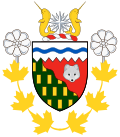| Commissioner of the Northwest Territories | |
|---|---|
| Commissaire des Territoires du Nord-Ouest | |
 Badge of the Commissioner of the Northwest Territories | |
 Flag of the Commissioner of the Northwest Territories | |
since 14 May 2024 | |
| Style | Honourable |
| Appointer | Governor-in-Council |
| Formation | 24 August 1905 |
| First holder | Frederick D. White |
| Website | www |
The commissioner of the Northwest Territories (French : Commissaire des Territoires du Nord-Ouest) is the Government of Canada's representative in the Northwest Territories. Similar in certain functions to a lieutenant governor, the commissioner swears in the members of the legislative assembly, swears in members of the executive council, assents to bills, opens sessions of the legislative assembly, and signs other government documents such as Orders in Council.
Contents
Earlier commissioners were mostly deputy ministers in various ministries (Minister of the Interior, Mines, Mines and Resources).
As commissioners are appointed by the Government of Canada, they are not a vice-regal representative in the territory — that is, unlike in Canada's provinces, there is no such thing as a "territorial Crown" analogous to the provincial Crowns. The commissioner represents the federal government and must follow any instructions of the Cabinet or the relevant federal minister, currently the Minister of Crown-Indigenous Relations and Northern Affairs.
Since 1980, the territories have had self-government, with the legislature choosing a government leader or premier, in addition to electing members of parliament to the Parliament of Canada.
